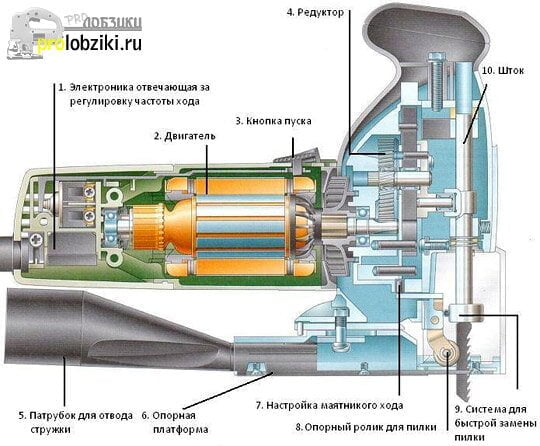The manual jigsaw started its victorious march around the world in 1944. It owes its appearance to the world renowned manufacturer Bosch. It was in 1944 that his first sample was released. For almost 70 years, the jigsaw has gone through many stages of development.
Now we have a handy, compact, high-performance and versatile power tool. With its help you can work with a variety of materials – wood, metal, plastic, drywall, tile, glass and even stone. With an electric jigsaw you can make a wide variety of cuts, limited only by the imagination of its owner. And all this is due to its excellent technical characteristics. Let’s look at them in detail.
The parts that make up an electric jigsaw

- Motor body. The most demanding part of the tool, because it houses the motor whose rotary motion is converted into a reciprocating movement of the slide through the shaft and gearbox. The main cutting part of the jigsaw, the saw blade or the jigsaw, is mounted on the slide.
- Gearbox. Sometimes it is made of plastic, which not only reduces the strength of the tool, but also worsens its heat dissipation. As a result, such a tool will heat up faster and with a greater probability will fail quickly. This is why a metal gear housing is preferable.
- The sole of the tool .. This element of the device plays an important role in making precise quality cuts in the material. Inexpensive models often use a stamped plate made of metal or, even worse, plastic. With such a tool you should not hope for quality work. The most preferable option is a cast metal soleplate. In addition to the material from which it is made, the reliability of its attachment to the jigsaw also plays a role. Fastening must be reliable and without backlash.
- Handle.
Types of jigsaw handles
- In the form of a staple. An example of such jigsaws would be Makita models 4327, Makita 4329. Convenient to use for nesting work, where you do not need a lot of shaped cuts.
- D-shaped .. A representative of this class is Hitachi models CJ 110 MV and CJ 120 V. With such a handle it is easy to give large smooth cutting lines.
- Mushroom-shaped .. BOSCH uses such handles in their GST 120E and GST135CE jigsaws. The mushroom-shaped handle allows the best performance on shaped cuts where turning requires a constant change of grip on the tool by the operator’s hand.
- Hacksaw blade or saw. In terms of the choice of jigsaws for the jigsaw., it is also an important point to ensure the quality of the cut at the proper level. The basic principle in the selection of the saw blade is the following: only appropriate blades should be used for different kinds of work and different materials. This prolongs the life of both the saw and the tool itself. Saw blades differ in:
- The material from which they are made.
- Teeth pitch.
- Sharpening and deburring method.
- The shape of the blade and teeth.
Blade classification:
- Made of high-carbon steel (labeled HCS) – themselves quite flexible and designed for working with soft materials.
- High Speed Steel (HSS) – for tougher materials.
- Bimetal (BiM) – a combination of the flexibility of the blade itself and the hardness of its teeth (or sputtering). Correspondingly, the blade is HCS, the teeth are HSS.
- Of durable material HM/TC allow you to work with fiberglass and even shingles.
- With a wavy edge. Used for working with non-ferrous metals.
- Saw blades with diamond or other coatings are used for ceramics, glass and other hard materials; with carbide tips.
- Special blades for tile.
- A splinterguard.To avoid chipping of cut material and to get a clean cut, various anti-slip devices are used. For example, Makita 4351FCT.; “Bosch” models GST 85PE, GST 120E (BE), GST 135BCE (CE). The choice of an appropriate blade and optimal speed of its movement contributes to the reduction of splintering.
К other important technical features и features of electric jigsaws are (vary depending on the manufacturer and model):
- saw speed adjustment;
- starting current limitation on start-up;
- multi-step pendulum stroke;
- possibility of quick saw blade change without additional tools;
- tool-free tilt adjustment of the base plate for oblique cuts;
- sawdust removal system and connection to vacuum cleaner;
- working area illumination.
When shopping for a tool, pay attention to these features of electric jigsaws, choosing the best option for you.
Read More: